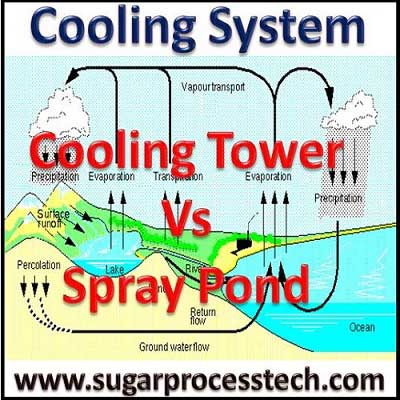In this article explained about Terms in cooling system, Design specification of cooling system and formula for Cooling System Efficiency. Finally discussed about difference between spray pond and cooling tower
Design specification of cooling system | Cooling Tower | Spray Pond
Condensing and cooling system plays a major role in sugar industry process house.
Essential Terms in cooling system
- Evaporation
- Dry Bulb
- Wet Bulb
- Absolute Humidity
- Relative Humidity
- Approach
Evaporation: In cooling process some quantity of water evaporated from the circulating water into the atmosphere in cooling system
Dry Bulb temperature (DBT): The DBT of the inlet or ambient air adjacent to the cooling tower as measured by a dry-bulb thermometer
Wet Bulb Temperature (WBT) : The lowest temperature to which the water can be cooled by contact with the air is the temperature indicated by the wet-bulb thermometer. The WBT readings are obtained by means of a mechanically aspirated psychrometer.
Relative Humidity: The ratio of the mole fraction of water vapour present in the air to the mole fraction of water vapour present in saturated air at the same temperature and barometric pressure is called relative humidity
Approach: The temperature difference between WBT of incoming air and outgoing temperature (cooling system outlet water) of water is known as “Cooling tower approach“.
Design specification of cooling systems
Water recirculation quantity calculation in cooling system of sugar process
To estimate cooling system capacity in sugar plant boiling house from four sources
1. Evaporator condenser: Quantity of vapour goes to condenser from evaporator set last body. Its quantity having generally in the range of 5 to 8% on cane.
2. Pan condensers: Total vapour load on condensers form all pans having 20 to 25% on cane. In case of back-end refinery it will increased upto 25 to 30% on cane.
3. Vacuum filter condenser: Total load on condenser including vapour and humid air having 0.8 to 1.2% on cane.
For more information please go through the below link
Rotary vacuum filter Equipment capacity details in sugar industry
4. Miscellaneous: Cooling water will be also used for odd duties such as ejector for vacuum crystallizers, NCG (non-condensible gases) and condensers common air ejector. Its total water requirement approximately 100% to 150% on cane
The total quantity of water circulating through the cooling system is about approximately 40 to 50 times the amount of vapour condensed. Its quantity depended upon the so many parameters like condenser efficiency, cooling system efficiency and wet bulb temperature.
For example 5000 TCD (210 TCH) plant cooling system water required
Vapour Load = 8% ( by evaporators) + 25% (By pans) + 1% (by vacuum filters) = 34% on cane
Total vapour load on condensers = 210 x 34% = 71.40 T/hr
Water required for vapour condensation = 71.40 x 50 = 3570 t/hr
Water required for ejectors = 210 x 150% = 315 t/hr
Total water required in cooling system = 3570 + 315 = 3885 t/hr ~ 4000 T/hr
Evaporation Rate in cooling system
The heat load to be removed in the cooling system is determined from the quantity of water and the change in temperature
Q = M x Cp x ( Ti – To)
Here Q = Quantity of heat load to be removed in evaporated in Kcal/kg
M = Water recirculation flow rate through the cooling system in T/hr.
Cp = Specific heat of water in Kcal/kg/oC
Ti = Water inlet temperature to cooling system ( Before cooling)
T0 = Water outlet temperature to cooling system ( After cooling)
For example M = 4000 t/hr ( recirculation flow rate),
Cp = 1 Kcal/kg/oC
Ti = 40 oC
T0 = 32 oC
Q = heat load to be removed in evaporated = 4000 x 1 x 8 = 32000 Kcal/kg
Latent heat of vaporization of water = 2260 KJ/kg = 540 Kca/kg
W = Quantity of water evaporation = 32000/540 = 59 T/hr
The proportion of the circulating water evaporated is about 2 to to 2.5% in circulation flow rate.
The cooling is directly dependent on the difference between the water temperature and the wet bulb temperature, both these temperatures are major factors affecting the size of the cooling system.
The wet bulb temperature is a function of the local conditions, and varies significantly during the course of the year.
A smaller quantity of water returning at a higher temperature may have the same heat duty to be removed as a system a larger quantity of water returning at a lower temperature.
However the higher temperature system will require a smaller cooling system because the difference between water and wet bulb temperature is higher.
Thus it is important to ensure that condensers have a close approach, returning the smallest quantity of water at the highest temperature possible.
Cooling System Efficiency
The efficiency of cooling system design of condenser play a very important role in reducing the consumption of water and power.
The efficiency “ “of the cooling system
Ti = temperature of the warm water entering the cooling system
To = temperature of the cold water leaving the cooling system
Twb= wet-bulb temperature.
Types of cooling system
There are two principal types of cooling system used in sugar factory
1. Spray Pond
2. Cooling Tower
The water is cooled by contact with cooler ambient air either in conventional cooling towers or in spray ponds. Most of the cooling occurs by evaporation and only a small proportion is by sensible heat transfer. Thus a significant proportion of the condensed vapour is evaporated in the cooling system.
Spray Pond Cooling System
Introduction: The spray pond cooling is the one of the simplest method of cooling the condenser water. In spray pond warm water is broken up into a spray by means of nozzles.
The hot water coming out of condenser is sprayed through the nozzles to expose maximum surface area of water to air for effective cooling.
Advantage
a) Pumping cost is low
b) Head required is less
c) Lesser wastage of water
d) Low drift losses
e) Least choking
f) Easy to maintain
g) High Durability and long life
Disadvantages
a) Large area is required. Approximately 25-50 times the area of cooling tower
b) Spray losses due to evaporation and windage losses
c) There is no control over the temperature of cooled water.
e) Cooling efficiency is low.
f) Cooling effect reduces with reduced wind velocity.
g) When load on the plant increases it does not respond to change.
Cooling Tower
Introduction: The cooling tower are desired when positive control on the temperature of water is required, the space occupied by the cooling system is considerable factor and the plant is situated near the load center.
Higher the surface area, more time of exposure, lower relative humidity, higher difference between WBT of air and water inlet temperature and cross flow gives effective cooling and reduced the tower size.
The cooling tower are mainly divided into two groups as Natural draft or Atmospheric cooling tower and Mechanical draft tower as per the air flow through the tower.
Advantages
a) Less floor space area required
b) Induced draft design with fan motor
c) More efficient compare to spray ponds.
Disadvantages
a) The carry over losses which are 0.2-0.6 % of water flow ,causes corrosion of blades forms the fog around tower with increase in carry over losses make up water required is also increased.
b) The drift droplets have the same chemical impurities as the circulating water and the deposition of these chemicals on object causes potential environmental concern.
c) Cooling tower where sewage effluent is uses for making up is highly conductive for growth of algae.
d) More maintenance.
Thanks for reading this article. I Hope it may fulfill your requirement regarding the ” Cooling System in industrial usage”. Give feed back, comments and please don’t forget to share it
Related Articles
Surface Condenser | Difference Between Jet Condenser and Surface Condenser
Fundamental Concepts of Overall Heat Transfer Coefficient (OHTC)


2 thoughts on “Water Cooling System | Difference Between Cooling Tower and Spray Pond”
Ajitesh De
(May 11, 2019 - 9:18 am)Want to know the type and constitution of chemicals used for cooling tower for process plant in sugar industry.
siva alluri
(May 22, 2019 - 2:55 pm)Actually there is no need of chemical for cooling tower in sugar process of defecation process.
In case of sulphitation process lime or soda ash or caustic soda required for maintaining the pH